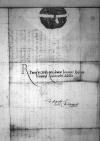Petivit a nobis per nuntium suum illustris dominus ⌊Albertus⌋ marchio Brandeburgensis in ⌊Prussia⌋ dux, nepos noster carissimus, ut providere dignaremur in ⌊terris nostris Prussiae⌋, quo per illustritatem eius et consiliarios istic nostros via et ratio iniretur, qua si quis factus esset in quamcumque partem hostium impetus, obviam illi iri posset, certus ut numerus equitum et peditum constitueretur, quo succurreretur his oppidis sive castris, quae primum hostes invasuri essent, sive ea nostra, sive domini ducis essent, ut coniunctis viribus altera pars alteri subsidio veniret et constitui certo posset, unde cuique arci et oppido praesidium esset exspectandum.
Quoniam vero absque consilio Paternitatis Vestrae et aliorum ⌊istarum terrarum nostrarum Prussiae consiliariorum⌋ tam gravi de re statuere aliquid non solemus, hortamur Paternitatem Vestram, ut quid illi de eo videatur, quod a nobis petit ⌊illustris dominus dux⌋, sententiam suam nobis perscribat, illud simul significet, differendane sit res ad proxima ⌊comitia Graudentina⌋, an primo quoque tempore, quod fieri vix posse putamus, comitia sint per nos edicenda, denique ubi locorum et per quos ea consultatio haberi debeat, litteris suis certiores nos reddat, factura pro gratia nostra et fide atque officio suo.


 BNW, BOZ, 953, f. 270v
BNW, BOZ, 953, f. 270v